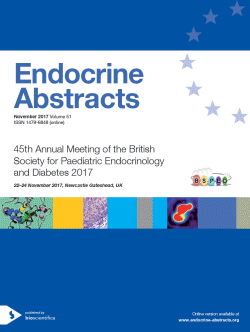
45th Meeting of the British Society for Paediatric Endocrinology and Diabetes
Poster Presentations
Miscellaneous/other
ea0051p019 | Miscellaneous/other | BSPED2017
Calcium/calmodulin dependent protein kinase 2 (CaMKK2) mutation – a novel genetic cause of congenital hyperinsulinism
Giri Dinesh , Scott John , Kemp Bruce , Didi Mohammed , Means Anthony , Senniappan Senthil
ea0051p020 | Miscellaneous/other | BSPED2017
Blood pressure monitoring and management in young girls with turner syndrome
Murtaza Mohammed Ibrar , McVey Lindsey , Fletcher Alexander , Anderson Ellen , Leighton Emma , Wong Jarod , Mason Avril
ea0051p021 | Miscellaneous/other | BSPED2017
Novel splicing mutation in B3GAT3 associated with short stature, GH deficiency, hypoglycaemia, developmental delay and multiple congenital anomalies
Bloor Samuel , Giri Dinesh , Didi Mohammed , Senniappan Senthil
ea0051p023 | Miscellaneous/other | BSPED2017
Exploring the growth and nutritional status in children with Prader-Willi syndrome
Martin Ruth , Meade Christina , Mc Crann Ann , Roche Edna
ea0051p024 | Miscellaneous/other | BSPED2017
Using CRISPR/Cas9 gene editing to study molecular mechanisms of congenital hyperinsulinism
Purushothaman Preetha , Aldossary Ahmad , Hart Stephen , Hussain Khalid
ea0051p026 | Miscellaneous/other | BSPED2017
Albright’s Hereditary Osteodystrophy associated with resistance to insulin and thyroid hormone in three male siblings
MacGloin Helen , Rangasami Jayanti , Dattani Mehul
ea0051p027 | Miscellaneous/other | BSPED2017
Is there an association between endocrine conditions, including growth hormone deficiency, and Chiari-1 Malformation? A retrospective single centre study
Elhag Sabba , Shah Jamie , Krone Ruth , Kershaw Melanie , Shaw Nick , Barrett Timothy , Kirk Jeremy , Saraff Vrinda , Hogler Wolfgang , Solanki Guirish , Dias Renuka
ea0051p028 | Miscellaneous/other | BSPED2017
Introducing a patient held record in a turner transition clinic, RHC Glasgow
ea0051p029 | Miscellaneous/other | BSPED2017
Bisphosphonate therapy in Williams-Beuren syndrome: case series
Maduemem Kene , Kennedy Elaine , Morrissey Rose , Riordan Michael , O'Riordan Stephen M P
ea0051p030 | Miscellaneous/other | BSPED2017
Audit of the management of patients with Turner’s syndrome in Northern Ireland
ea0051p031 | Miscellaneous/other | BSPED2017
Early puberty in Klinefelter syndrome
Vasista Pooja , Greening James , Tziaferi Vaya
ea0051p032 | Miscellaneous/other | BSPED2017
Cutaneous rash mimicking acanthosis nigricans in a child with type 1 diabetes mellitus
ea0051p033 | Miscellaneous/other | BSPED2017
When feeding becomes excessive! An unusual case of psychogenic polydipsia
ea0051p034 | Miscellaneous/other | BSPED2017
Intrauterine growth restriction as a presentation of 17q12 deletion
Hilal Mohamad , Pasupuleti Spandana , Sakamudi Jayabharathi
ea0051p035 | Miscellaneous/other | BSPED2017
Post-prandial hyerinsulinaemic hypoglycaemia post-esophageal surgery in children
Malhotra Neha , Dastamani Antonia , Guemes Maria , Gilbert Clare , Ress Clare , Dattani Mehul , Shah Pratik
ea0051p036 | Miscellaneous/other | BSPED2017
Quantification of appetite-regulating hormones in hypothalamic and simple obesity
Gan Hoong-Wei , Leeson Clare , Aitkenhead Helen , Farooqi Sadaf , Spoudeas Helen , Martinez-Barbera Juan Pedro , Dattani Mehul



